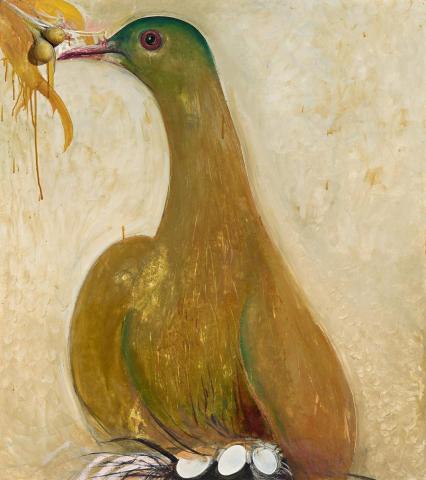ORANGE FRUIT DOVE, FIJI, 1969
BRETT WHITELEY
oil and mixed media on composition board
136.5 x 122.0 cm
signed and inscribed verso: A938 / Brett Whiteley Fiji / 'Orange fruit dove'
Private collection, Adelaide
Philip Bacon Galleries, Brisbane
Brigadier R.W.P. Dodd, MC (CMF), Queensland, acquired from the above in 1977
Thence by descent
Estate of Molly Dodd, Queensland
Brett Whiteley, Bonython Art Gallery, Sydney, June – July 1970
Brett Whiteley: Art & Life, Art Gallery of New South Wales, Sydney 16 September – 19 November 1995; Museum and Art Gallery of the Northern Territory, Darwin, 13 December 1995 – 28 January 1996; Art Gallery of Western Australia, Perth, 22 February – 8 April 1996; Art Gallery of South Australia, Adelaide, 9 May – 16 June 1996; National Gallery of Victoria, Melbourne, 2 July – 26 August 1996; Tasmanian Museum and Art Gallery, Hobart, 18 September – 17 November 1996
Philip Bacon Galleries 40th Anniversary, Philip Bacon Galleries, Brisbane, 18 February – 15 March 2014, cat. 27 (loan exhibition, label attached verso)
Pearce, B., Brett Whiteley: Art & Life, Thames and Hudson in association with the Art Gallery of New South Wales, Sydney, 1995, p. 235, pl. 144 (illus.)
Philip Bacon Galleries: 40 Years 40 Paintings, Philip Bacon Galleries, Brisbane, 2014, p. 31 (illus.)
Of Brett Whiteley's many star-studded paintings, those of birds are among his finest. Their quality and beauty have been acclaimed, the Sydney poet, Robert Gray writing, 'In Whiteley's bird paintings is embodied his finest feeling; they are to me his best work.'1 His retrospective exhibition organized by the Art Gallery of New South Wales for tour in 1995-1996 included, as well as our painting, a number of works in which birds were the subject - the oil and collage White Dove in Avocado Tree, 1979 and the 1988 bronze sculptures Pelican II and Hummingbird being splendid examples. Eggs and twigs were often added as collage, his inventiveness including ping-pong balls, a leather boot, paint and steel for Boot Owl, 1985. The Orange Fruit Dove was Whiteley's favourite, having written on the back of his 1988 painting, Orange Fijian Fruit Dove, 'probably for me / the most / beautiful bird / in the world'. Leaving the frenzy of New York for the island paradise of Fiji, in 1969, Whiteley's Fruit Dove series of paintings had their genesis there. Others followed in 1979 and later. Our painting, one of the first, pulsates with all that visual excitement of a new experience, entrancingly seductive to the eye, intoxicating all the senses. Here, acute perception of eye and masterly talent for drawing combined to create an individuality of form, striking in its seeming simplicity, dressed in an abundant richness of colour. Enthralled by the bird's beauty, Whiteley generously shares his rapture with the viewer, especially through his employment of embracing rhythms. The repetition of ovals in the body of the dove, its wings, nesting eggs and fruit which it enjoys, is like a leitmotif in music, taken up in the elegant, curvaceous outlines to the left. Returning to Robert Gray, who wrote:
'I like in the bird shapes that clarity; that classical, haptic shapeliness; that calm - those clear, perfect lines of a Chinese vase. The breasts of his birds swell with the most attractive emotion in his work: It is bold, vulnerable, and tender.'2
His reference to the Chinese vase places Whiteley's art among the most rewarding aesthetic experiences, allied to philosophic thought. While stillness commands the flight-filled form in Orange Fruit Dove, Fiji, it offers an enveloping metaphor of freedom, both of body and spirit. It calls to soar high, unrestrained by things terrestrial in harmony with being and nature's plenitude. The sensory is one of Whiteley's principal tools. The cerebral is equally significant, all be it decked out in the profligate splendour of his technical and creative mastery.
1. Gray, R., 'A few takes on Brett Whiteley', Art and Australia, vol. 24, no. 2, Summer 1986, p. 222
2. Ibid.
DAVID THOMAS
